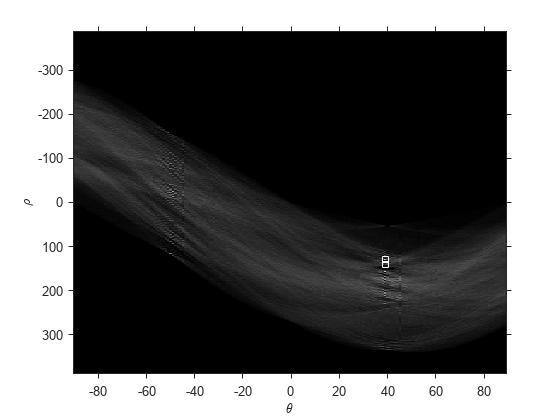houghpeaks
Identify peaks in Hough transform
Description
peaks = houghpeaks(H,numpeaks,Name=Value)
Examples
Read image into workspace.
I = imread('circuit.tif');Create binary image.
BW = edge(imrotate(I,50,'crop'),'canny');
Create Hough transform of image.
[H,T,R] = hough(BW);
Find peaks in the Hough transform of the image and plot them.
P = houghpeaks(H,2); imshow(H,[],'XData',T,'YData',R,'InitialMagnification','fit'); xlabel('\theta'), ylabel('\rho'); axis on, axis normal, hold on; plot(T(P(:,2)),R(P(:,1)),'s','color','white');

Input Arguments
Hough transform matrix, specified as a numeric array. The rows and columns correspond to
rho and theta values. Use the
hough function to create a
Hough transform matrix.
Data Types: double
Maximum number of peaks to identify, specified as a positive integer.
Data Types: double
Name-Value Arguments
Specify optional pairs of arguments as
Name1=Value1,...,NameN=ValueN, where Name is
the argument name and Value is the corresponding value.
Name-value arguments must appear after other arguments, but the order of the
pairs does not matter.
Example: P = houghpeaks(H,2,Threshold=15) specifies that the
minimum value to be considered a peak is 15.
Before R2021a, use commas to separate each name and value, and enclose
Name in quotes.
Example: P = houghpeaks(H,2,"Threshold",15);
Minimum value to be considered a peak, specified as a nonnegative number.
Data Types: double
Size of the suppression neighborhood, specified as a 2-element vector
of positive odd integers. The suppression
neighborhood is the neighborhood around each peak that
is set to zero after the peak is identified. The default value of
NHoodSize is the smallest odd values greater
than or equal to size(H)/50. The dimensions of
NHoodSize must be smaller than the size of the
Hough transform matrix, H.
Data Types: double
Hough transform theta values, specified as a numeric vector returned
by the hough function. Each element of the vector
specifies the theta value for the corresponding
column of the output matrix H.
houghpeaks uses the theta
values specified for peak suppression. Use the hough function to
create a Hough transform matrix.
Note
If you specify the Theta argument as input to
the hough function, then you must specify the
returned theta value with the
houghpeaks function. Use the
theta output value from the
hough function as the
Theta input value for
houghpeaks. Otherwise, peak suppression can
result in unexpected results.
Data Types: double
Output Arguments
Row and column coordinates of found peaks, returned as a
Q-by-2 matrix. The value Q can
range from 0 to numpeaks.
Extended Capabilities
Usage notes and limitations:
houghpeakssupports the generation of C and C++ code (requires MATLAB® Coder™). For more information, see Code Generation for Image Processing.String arguments must be compile-time constants.
Usage notes and limitations:
String arguments must be compile-time constants.
Version History
Introduced before R2006a
MATLAB Command
You clicked a link that corresponds to this MATLAB command:
Run the command by entering it in the MATLAB Command Window. Web browsers do not support MATLAB commands.
Website auswählen
Wählen Sie eine Website aus, um übersetzte Inhalte (sofern verfügbar) sowie lokale Veranstaltungen und Angebote anzuzeigen. Auf der Grundlage Ihres Standorts empfehlen wir Ihnen die folgende Auswahl: .
Sie können auch eine Website aus der folgenden Liste auswählen:
So erhalten Sie die bestmögliche Leistung auf der Website
Wählen Sie für die bestmögliche Website-Leistung die Website für China (auf Chinesisch oder Englisch). Andere landesspezifische Websites von MathWorks sind für Besuche von Ihrem Standort aus nicht optimiert.
Amerika
- América Latina (Español)
- Canada (English)
- United States (English)
Europa
- Belgium (English)
- Denmark (English)
- Deutschland (Deutsch)
- España (Español)
- Finland (English)
- France (Français)
- Ireland (English)
- Italia (Italiano)
- Luxembourg (English)
- Netherlands (English)
- Norway (English)
- Österreich (Deutsch)
- Portugal (English)
- Sweden (English)
- Switzerland
- United Kingdom (English)